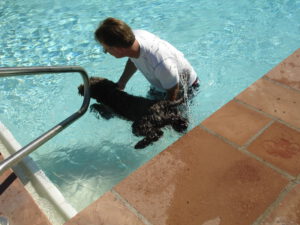I have three levels of dog training classes: Basic, Intermediate, and Advanced. Most students just do Basic, primarily because they feel this program is sufficient for their needs, and also because that is all that their budget will allow. Here’s more on how I see these classes. There are three common elements of each level…

For example, Basic Obedience fundamentals include how to greet and pet a dog; put on a leash and collar; give commands; apply learning theories; purchase supplies; manage your time during a lesson; read your dog; carry yourself around a dog, use a crate, view basic safety, teach each of the Basic commands, deploy swimming basics (for students who have dogs that must learn to swim) and so on. Second, we go over “when and why” discussions which include physical and mental practice, to choose the right actions and applying the Basic Obedience fundamentals at the right times. There are a number of situations that the student may be trained to perceive and handle (depending upon their goals, type of dog, lifestyle, etc.) such as manners at the front door; dealing with multiple pets in the home; greeting strangers; dealing with strangers and unknown off leash dogs; traffic; escapes; and misbehaviors. Lastly, we do real world training, more demanding than what we’ve done prior, which allows the students to apply what they have learned. The random nature of training a dog in public allows the students to see all of this in the chaos of life, and gives them opportunities to make decisions and necessary learning mistakes.
These three elements (fundamentals, when and why, and real world training) are also incorporated at the Intermediate level, and lastly at the Advanced Level. In many ways, it is like how a student is trained in a good martial arts class. When I was a kid, I took some Judo classes. We started out with simple defensive moves, primarily how to fall. Then very basic throws. Those basics allowed me to defend myself from a bully. As an adult, I took 2 ½ years of Brazilian Jiu-jitsu. I remember starting out, not knowing a thing, and feeling very self-conscious about being an out-of-shape novice. They started with a lot of fitness work, and very basic fundamentals, and beginning Judo moves. Everything at first was also defensive in nature. You’d overhear the instructors and advanced students discuss the “when and why” aspects of fighting. We also had opportunities to enter tournaments. I eventually earned my Blue belt, and a couple of stripes on my belt, and entered my first tournament. The three elements were applied at each belt level. We learned the fundamentals of that belt, “when and why” to apply those fundamentals; and then we were encouraged to enter tournaments to get a chance to fight others that were not your friends and who might actually hurt you. In the one tournament I entered, I heard a guy break his arm. It sounded like someone had broken a wooden baseball bat. You could hear it crack in a large auditorium, and you also heard the guy cry out in pain. Everyone waited until first responders arrived and took him to the hospital. Yeah, that shook me up, and made me very wary during my match. It was no longer just a game, this was real. It added to my “streetwise” viewpoints on life. I also learned a lot about “learning” from these classes, and I took those same concepts and used them to change how I trained my students.
The student’s dogs are similarly trained. They get the fundamentals. They learn the “when and why”. And they get opportunities to do all of this in real work situations until they are proficient and working well with their owners.
Owners that are just looking to go through the motions never get the most out of my classes, however. They get good training. Those that “get” what we are doing, and dig in, get great training. The students that go onto Intermediate and Advanced lessons develop amazing dogs. This is where they see how smart and capable their dogs really are.
Great dog training classes are much more than teaching a dog to Sit, Down, Come and Heel. To get the most out of the training, it must go way beyond that. This is what makes my classes different. There is much more depth to what we do than you see in your typical dog training program. It is much more meaningful and lasting, for the students and dogs. I like this type of training, you and your dog will, too.
